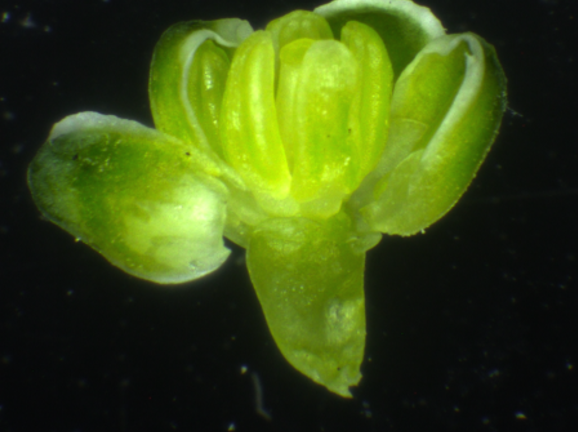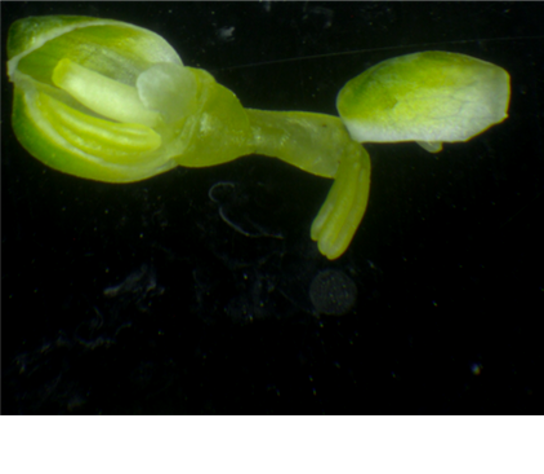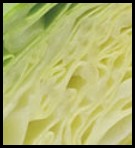"分析甘藍類蔬菜器官發育與細胞生理變化" 修訂間的差異
| (未顯示由 4 位使用者於中間所作的 8 次修訂) | |||
| 行 1: | 行 1: | ||
| + | <s4e> | ||
| + | pid=194 | ||
| + | show=原始設計者;簡介 | ||
| + | </s4e> | ||
| + | |||
<table style='border:none'> | <table style='border:none'> | ||
<tr> | <tr> | ||
| 行 5: | 行 10: | ||
十字花科甘藍類蔬菜為溫帶作物,在臺灣主要以目前秋冬季時節為主要產季,大都經由人擇,野生甘藍藉由育種而育成許多變種與品系,在育種的過程中主要選拔能儲存養分之膨大器官,例如:莖、花、葉以供作人類食用與營養來源。 | 十字花科甘藍類蔬菜為溫帶作物,在臺灣主要以目前秋冬季時節為主要產季,大都經由人擇,野生甘藍藉由育種而育成許多變種與品系,在育種的過程中主要選拔能儲存養分之膨大器官,例如:莖、花、葉以供作人類食用與營養來源。 | ||
| − | <img | + | <img src="https://upload.wikimedia.org/wikipedia/commons/thumb/2/20/%E5%8D%81%E5%AD%97%E8%8A%B1%E7%A7%91%E8%82%B2%E7%A8%AE.png/800px-%E5%8D%81%E5%AD%97%E8%8A%B1%E7%A7%91%E8%82%B2%E7%A8%AE.png" width="800"> |
| + | |||
| + | |||
| 行 21: | 行 28: | ||
| − | == 現象說明:== | + | == 1.現象說明:== |
<table> | <table> | ||
<tr> | <tr> | ||
| 行 39: | 行 46: | ||
</table> | </table> | ||
| − | + | ||
| − | == | + | |
| + | == 2.探究問題:(此為引導,學習者必須要提出合理的假說)== | ||
<table style="border-width: 30px; border-style: dotted; border-color: white;"> | <table style="border-width: 30px; border-style: dotted; border-color: white;"> | ||
<tr> | <tr> | ||
| 行 65: | 行 73: | ||
<tr> | <tr> | ||
<td>(1) | <td>(1) | ||
| − | <img | + | <img src="https://upload.wikimedia.org/wikipedia/commons/0/00/%E7%90%83%E8%8E%96%E7%94%98%E8%97%8D.jpg" width="100"> |
</td> | </td> | ||
<td>1份 | <td>1份 | ||
</td> | </td> | ||
<td> | <td> | ||
| − | (5)~(8) | + | (5)~(8)<br> |
| − | <img | + | <img src="https://upload.wikimedia.org/wikipedia/commons/2/2d/%E6%A4%8D%E7%89%A9%E8%A1%A8%E7%9A%AE%E7%B5%84%E7%B9%94.jpg" width="180"> |
</td> | </td> | ||
<td>1份 | <td>1份 | ||
| 行 79: | 行 87: | ||
<tr> | <tr> | ||
<td>(2) | <td>(2) | ||
| − | <img | + | <img src="https://upload.wikimedia.org/wikipedia/commons/b/bc/%E8%8A%B1%E6%A4%B0%E8%8F%9C.jpg" width="100"> |
</td> | </td> | ||
<td>1份 | <td>1份 | ||
</td> | </td> | ||
<td> | <td> | ||
| − | (9) | + | (9)<br> |
| − | <img | + | <img src="https://upload.wikimedia.org/wikipedia/commons/4/47/%E7%B4%AB%E7%94%98%E8%97%8D.jpg" width="100"> |
</td> | </td> | ||
<td>1份 | <td>1份 | ||
| 行 91: | 行 99: | ||
</tr><tr> | </tr><tr> | ||
<td>(3) | <td>(3) | ||
| − | <img | + | <img src="https://upload.wikimedia.org/wikipedia/commons/f/f2/%E7%B5%90%E7%90%83%E7%94%98%E8%97%8D.jpg" width="100"> |
</td> | </td> | ||
<td>1份 | <td>1份 | ||
</td> | </td> | ||
<td> | <td> | ||
| − | (10)~(13) | + | (10)~(13)<br> |
| − | <img | + | <img src="https://upload.wikimedia.org/wikipedia/commons/3/38/Eppendorf.png" width="180"> |
</td> | </td> | ||
<td>1份 | <td>1份 | ||
| 行 103: | 行 111: | ||
</tr><tr> | </tr><tr> | ||
<td>(4) | <td>(4) | ||
| − | <img | + | <img src="https://upload.wikimedia.org/wikipedia/commons/2/21/%E9%9D%92%E8%8A%B1%E8%8F%9C.jpg" width="100"> |
</td> | </td> | ||
<td>1份 | <td>1份 | ||
| 行 118: | 行 126: | ||
</tr> | </tr> | ||
</table> | </table> | ||
| − | == 設計實驗與執行== | + | == 3.設計實驗與執行== |
<table style='border:none'> | <table style='border:none'> | ||
| 行 153: | 行 161: | ||
</td> | </td> | ||
| − | <td><img | + | <td><img src="https://upload.wikimedia.org/wikipedia/commons/0/03/%E5%B0%87%E6%9F%93%E6%B6%B2T%E6%B5%B8%E6%BD%A4%E8%87%B3%E8%91%89%E7%89%87%E6%A8%A3%E6%9C%AC%E4%B9%8B%E7%B5%84%E7%B9%94%E7%B4%B0%E8%83%9E%E9%96%93%E9%9A%99.png" width="500"> |
| + | |||
| + | |||
<center><b>圖二:將染液T浸潤至葉片樣本(5)(6)(7)(8)之組織細胞間隙實驗步驟。</b></center> | <center><b>圖二:將染液T浸潤至葉片樣本(5)(6)(7)(8)之組織細胞間隙實驗步驟。</b></center> | ||
</td> | </td> | ||
| 行 160: | 行 170: | ||
| − | == 分析與結論== | + | == 4.分析與結論== |
*4.1 能分析和比較十字花科甘藍類蔬菜之特徵。 | *4.1 能分析和比較十字花科甘藍類蔬菜之特徵。 | ||
| 行 168: | 行 178: | ||
| − | == 教學目標與評量== | + | == 5.教學目標與評量== |
*5.1 能實際用肉眼、解剖顯微鏡與光學顯微鏡觀察樣本。 | *5.1 能實際用肉眼、解剖顯微鏡與光學顯微鏡觀察樣本。 | ||
*5.2 能歸納整理實驗結果並得出結論。 | *5.2 能歸納整理實驗結果並得出結論。 | ||
| − | ==參考資料== | + | ==6.參考資料== |
*http://imbrickle.blogspot.tw/2008/05/artificial-selection-produces.html | *http://imbrickle.blogspot.tw/2008/05/artificial-selection-produces.html | ||
*Chen CC, Fu SF, Norikazu M, Yang YW, Liu YL, Ikeo K, Gojobori T and Huang HJ (2015) Comparative miRNAs analysis of two contrasting broccoli inbred lines with divergent head-forming capacity under temperature stress. BMC Genomics 16:1026 | *Chen CC, Fu SF, Norikazu M, Yang YW, Liu YL, Ikeo K, Gojobori T and Huang HJ (2015) Comparative miRNAs analysis of two contrasting broccoli inbred lines with divergent head-forming capacity under temperature stress. BMC Genomics 16:1026 | ||
| − | ==解答== | + | ==7.解答== |
*3.1 觀察分析植物樣本(1)~(4): | *3.1 觀察分析植物樣本(1)~(4): | ||
**3.1.1 何者主要食用部位包含器官莖、花、葉?<font color=red>(4)(3)(2)</font> | **3.1.1 何者主要食用部位包含器官莖、花、葉?<font color=red>(4)(3)(2)</font> | ||
| − | **3.1.2 何者為青花菜、花椰菜、球莖甘藍、結球甘藍?<font color=red>青花菜:( | + | **3.1.2 何者為青花菜、花椰菜、球莖甘藍、結球甘藍?<font color=red>青花菜:(4)、花椰菜:(2)、球莖甘藍:(1)、結球甘藍:(3)</font> |
*3.2 以解剖顯微鏡觀察分析植物樣本(2)和(4): | *3.2 以解剖顯微鏡觀察分析植物樣本(2)和(4): | ||
| 行 195: | 行 205: | ||
*3.4以光學顯微鏡觀察植物樣本(5)~(8)之表皮組織: | *3.4以光學顯微鏡觀察植物樣本(5)~(8)之表皮組織: | ||
**3.4.1繪製樣本(5)的形態 | **3.4.1繪製樣本(5)的形態 | ||
| − | <img | + | <img src="https://upload.wikimedia.org/wikipedia/commons/8/8a/%E8%A1%A8%E7%9A%AE%E7%B5%84%E7%B9%94%E7%A4%BA%E6%84%8F%E5%9C%96.jpg" width="150"> |
| + | |||
| + | |||
**3.4.2相同倍率下,何者的細胞數目最多?<font color=red>(6)</font> | **3.4.2相同倍率下,何者的細胞數目最多?<font color=red>(6)</font> | ||
**3.4.2相同倍率下,何者細胞形態最大?<font color=red>(7)</font> | **3.4.2相同倍率下,何者細胞形態最大?<font color=red>(7)</font> | ||
| 行 202: | 行 214: | ||
**3.5.1請利用所提供之10 mL針筒與染液T,實驗步驟如圖二,將染液T浸潤至樣本(5)(6)(7)(8)之組織細胞間隙,進行染色。(預防噴濺請務必使用護目鏡) | **3.5.1請利用所提供之10 mL針筒與染液T,實驗步驟如圖二,將染液T浸潤至樣本(5)(6)(7)(8)之組織細胞間隙,進行染色。(預防噴濺請務必使用護目鏡) | ||
**3.5.2如何辨別染液T已完全浸潤到葉片組織間隙? | **3.5.2如何辨別染液T已完全浸潤到葉片組織間隙? | ||
| − | <img | + | <img src="https://upload.wikimedia.org/wikipedia/commons/thumb/c/c5/%E5%B0%87%E6%9F%93%E6%B6%B2T%E6%B5%B8%E6%BD%A4%E8%87%B3%E8%91%89%E7%89%87%E6%A8%A3%E6%9C%AC%E4%B9%8B%E7%B5%84%E7%B9%94%E7%B4%B0%E8%83%9E%E9%96%93%E9%9A%99-2.png/800px-%E5%B0%87%E6%9F%93%E6%B6%B2T%E6%B5%B8%E6%BD%A4%E8%87%B3%E8%91%89%E7%89%87%E6%A8%A3%E6%9C%AC%E4%B9%8B%E7%B5%84%E7%B9%94%E7%B4%B0%E8%83%9E%E9%96%93%E9%9A%99-2.png" width="500"> |
| − | + | <img src="https://upload.wikimedia.org/wikipedia/commons/3/3b/%E7%94%A8%E9%87%9D%E7%AD%92%E6%B5%B8%E6%BD%A4.jpg" width="50"> | |
*3.5.3植物樣本(5)(6)(7)(8),何者具有最強之細胞呼吸作用活力?<font color=red>(6)</font> | *3.5.3植物樣本(5)(6)(7)(8),何者具有最強之細胞呼吸作用活力?<font color=red>(6)</font> | ||
**3.5.4植物樣本(5)(6)(7)(8)何者最有可能位於為植株該器官之最內層部位?<font color=red>(6)</font> | **3.5.4植物樣本(5)(6)(7)(8)何者最有可能位於為植株該器官之最內層部位?<font color=red>(6)</font> | ||
| 行 211: | 行 223: | ||
**3.6.2判別試劑(10)~(13)何者為高張中性溶液?<font color=red>(13)</font> | **3.6.2判別試劑(10)~(13)何者為高張中性溶液?<font color=red>(13)</font> | ||
**3.6.3判別試劑(10)~(13)何者為小蘇打溶液?<font color=red>(10)</font> | **3.6.3判別試劑(10)~(13)何者為小蘇打溶液?<font color=red>(10)</font> | ||
| − | <img | + | <img src="https://upload.wikimedia.org/wikipedia/commons/c/cc/%E7%94%98%E8%97%8D.jpg" width="150"> |
| − | + | <img src="https://upload.wikimedia.org/wikipedia/commons/thumb/e/ea/%E7%94%98%E8%97%8D%E7%9A%84%E8%8A%B1-1.tif/lossless-page1-534px-%E7%94%98%E8%97%8D%E7%9A%84%E8%8A%B1-1.tif.png" width="150"> | |
| − | <img | + | <img src="https://upload.wikimedia.org/wikipedia/commons/thumb/c/c2/%E7%94%98%E8%97%8D%E7%9A%84%E8%8A%B1-2.tif/lossless-page1-578px-%E7%94%98%E8%97%8D%E7%9A%84%E8%8A%B1-2.tif.png" width="150"> |
| − | + | <img src="https://upload.wikimedia.org/wikipedia/commons/thumb/a/a0/%E7%94%98%E8%97%8D%E7%9A%84%E8%8A%B1-3.tif/lossless-page1-544px-%E7%94%98%E8%97%8D%E7%9A%84%E8%8A%B1-3.tif.png" width="150"> | |
| − | <img | + | <br> |
| + | <img src="https://upload.wikimedia.org/wikipedia/commons/thumb/0/0b/%E8%A1%A8%E7%9A%AE%E7%B4%B0%E8%83%9E.tif/lossless-page1-236px-%E8%A1%A8%E7%9A%AE%E7%B4%B0%E8%83%9E.tif.png" width="100"> | ||
| + | <img src="https://upload.wikimedia.org/wikipedia/commons/thumb/9/9d/%E8%A1%A8%E7%9A%AE%E7%B4%B0%E8%83%9E-2.jpg/800px-%E8%A1%A8%E7%9A%AE%E7%B4%B0%E8%83%9E-2.jpg" width="600"> | ||
| + | <br> | ||
| + | <img src="https://upload.wikimedia.org/wikipedia/commons/thumb/2/23/%E7%B5%84%E7%B9%94%E6%9F%93%E8%89%B2.png/799px-%E7%B5%84%E7%B9%94%E6%9F%93%E8%89%B2.png" width="500"> | ||
| + | <img src="https://upload.wikimedia.org/wikipedia/commons/0/04/%E7%B5%84%E7%B9%94%E6%9F%93%E8%89%B2%E7%B5%90%E6%9E%9C.png" width="100"> | ||
於 2020年2月20日 (四) 06:58 的最新修訂
原始設計者:彰師大
|
十字花科甘藍類蔬菜為溫帶作物,在臺灣主要以目前秋冬季時節為主要產季,大都經由人擇,野生甘藍藉由育種而育成許多變種與品系,在育種的過程中主要選拔能儲存養分之膨大器官,例如:莖、花、葉以供作人類食用與營養來源。
|
1.現象說明:
|
|
2.探究問題:(此為引導,學習者必須要提出合理的假說)
|
|
3.設計實驗與執行
|

|
4.分析與結論
- 4.1 能分析和比較十字花科甘藍類蔬菜之特徵。
- 4.2 能夠操作T染劑進行組織染色。
- 4.3 能從實驗操作的結果(組織顏色的變化)來分析試劑的性質。
5.教學目標與評量
- 5.1 能實際用肉眼、解剖顯微鏡與光學顯微鏡觀察樣本。
- 5.2 能歸納整理實驗結果並得出結論。
6.參考資料
- http://imbrickle.blogspot.tw/2008/05/artificial-selection-produces.html
- Chen CC, Fu SF, Norikazu M, Yang YW, Liu YL, Ikeo K, Gojobori T and Huang HJ (2015) Comparative miRNAs analysis of two contrasting broccoli inbred lines with divergent head-forming capacity under temperature stress. BMC Genomics 16:1026
7.解答
- 3.1 觀察分析植物樣本(1)~(4):
- 3.1.1 何者主要食用部位包含器官莖、花、葉?(4)(3)(2)
- 3.1.2 何者為青花菜、花椰菜、球莖甘藍、結球甘藍?青花菜:(4)、花椰菜:(2)、球莖甘藍:(1)、結球甘藍:(3)
- 3.2 以解剖顯微鏡觀察分析植物樣本(2)和(4):
- 3.2.1樣本(2)(4)的花辦數目分別為何? 0, 4
- 3.2.2樣本(2)(4)的雄蕊數量分別為何? 0, 5
- 3.2.3樣本(2)(4)的雌蕊數量分別為何? 0, 1
- 3.3分析3-1和3-2觀察之結果:
- 3.3.1樣本(2)(4)組織形態是否為相同?否
- 3.3.2樣本(2)(4)在器官發育上何者為先?(4)
- 3.3.3樣本(1)~(4)中,何者為可孕性能較先進行有性生殖?(4)
- 3.4以光學顯微鏡觀察植物樣本(5)~(8)之表皮組織:
- 3.4.1繪製樣本(5)的形態

- 3.4.2相同倍率下,何者的細胞數目最多?(6)
- 3.4.2相同倍率下,何者細胞形態最大?(7)
- 3.5染液T為無色,組織染色靜置約10~20分後,紅色反應可用來呈現組織細胞呼吸作用活力:
- 3.5.1請利用所提供之10 mL針筒與染液T,實驗步驟如圖二,將染液T浸潤至樣本(5)(6)(7)(8)之組織細胞間隙,進行染色。(預防噴濺請務必使用護目鏡)
- 3.5.2如何辨別染液T已完全浸潤到葉片組織間隙?


- 3.5.3植物樣本(5)(6)(7)(8),何者具有最強之細胞呼吸作用活力?(6)
- 3.5.4植物樣本(5)(6)(7)(8)何者最有可能位於為植株該器官之最內層部位?(6)
- 3.6以光學顯微鏡觀察樣本表皮組織。若細胞內紫色色素在酸性中會呈現紅色;鹼性則是呈現藍紫色:
- 3.6.1紫色色素主要分佈於何種細胞?表皮細胞
- 3.6.2判別試劑(10)~(13)何者為高張中性溶液?(13)
- 3.6.3判別試劑(10)~(13)何者為小蘇打溶液?(10)















